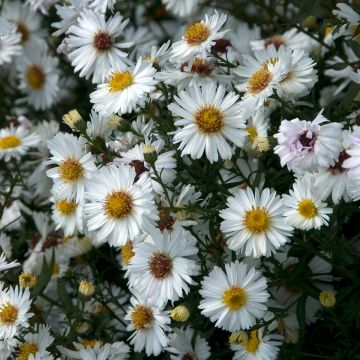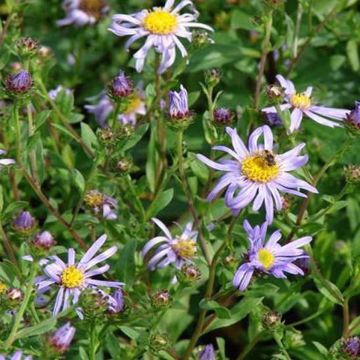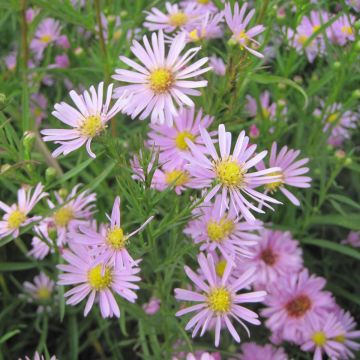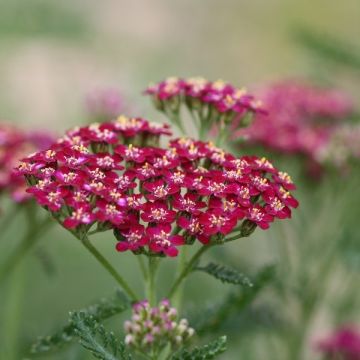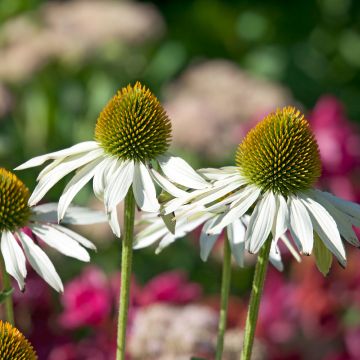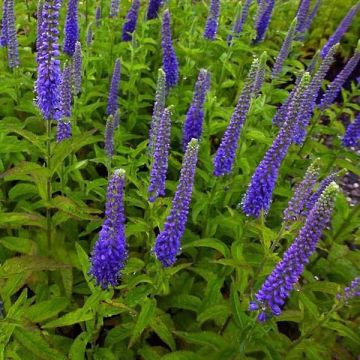

Aster ericoides Blue Star
Aster ericoides Blue Star
Aster ericoïdes Blue Star
Heath Aster, White Heath Aster
Small plants far from the non-binding picture. Replaced by a very responsive customer service as always. To be continued.
Fab, 06/05/2023
This item cannot be shipped to the selected country
Delivery charge from €5.90
More information
Schedule delivery date,
and select date in basket
This plant carries a 12 months recovery warranty
More information
We guarantee the quality of our plants for a full growing cycle, and will replace at our expense any plant that fails to recover under normal climatic and planting conditions.
From €5.90 for pickup delivery and €6.90 for home delivery
Express home delivery from €8.90.

Does this plant fit my garden?
Set up your Plantfit profile →
Description
Aster ericoides 'Blue Star' is a fairly recent variety of heath aster, with a lovely lavender-blue flowering, a colour that was previously non-existent in asters of this category. It is a fairly compact, floriferous variety that forms a bush covered with generous bluish and vaporous panicles, weighed down by the weight of the flowers. This aster is ornamental even outside of the late summer flowering, as it forms a bush with a light appearance, covered with small narrow leaves. It is a problem-free perennial and a charming addition to flower beds, which also adds a lot of lightness to September bouquets.
Symphyotrichum ericoides (modern name of Aster ericoides) belongs to the Asteraceae family. It is native to the eastern and central United States, as well as northern Mexico. 'Blue Star' is a cultivar selected for its more compact habit than the type and its bluish flowering. The plant has an upright and bushy habit, reaching a height of 80 to 90cm (32 to 35in), with a spread of 50cm (20in). The very generous and long flowering period takes place from September (sometimes late August depending on the climate) to October-November. The plant is then covered with hundreds of small pale lavender-blue flowerheads with a brown centre, measuring 1cm (1in) in diameter, in pendulous panicles. The flowers are appreciated by butterflies. The dark green foliage is very fine and composed of small, pointed, lanceolate leaves, carried by thin, sturdy and branched stems.
It is impossible to imagine our gardens without asters. This one is particularly undemanding when it comes to soil type; it even tolerates drought quite well when planted in deep soil. It pairs perfectly with grasses; choose from the most reasonable and least demanding, for example Eragrostis spectabilis (pink cloud in August), Muhlenbergia capillaris (pink in autumn), or Miscanthus sinensis 'Yaku Jima'. It gets along well with most plants in the flower bed, such as Salvia microphylla, Crocosmia 'Meteore', Rudbeckia triloba, or Aster cordifolius and its cultivars 'Ideal' or 'Little Carlow'. Asters grow quickly and can fill in empty spaces in a recently planted hedge. In a flower bed, you can create layers and rounded, fluffy volumes by combining asters of different statures and sizes, for example with Aster ericoides prostratus 'Snow flurry', A. laevis, or A. turbinellus. Pair with autumn-flowering roses, which are perfectly highlighted by its mist of small flowers. This plant is also an excellent cut flower.
Report an error about the product description
Aster ericoides Blue Star in pictures




Flowering
Foliage
Plant habit
Botanical data
Aster
ericoïdes
Blue Star
Asteraceae
Heath Aster, White Heath Aster
Symphyotrichum ericoides
Cultivar or hybrid
Other Asters
Planting and care
Plant 'Blue Star' in autumn or spring in ordinary, moist but well-drained soil that is occasionally dry. It will tolerate clayey or stony soil. It appreciates a sunny exposure but also tolerates partial shade where it will have a slightly looser habit. Protect it from strong winds that could flatten the clumps. In a mass planting, leave at least 50cm (20in) spacing between the plants. Prune the faded stems to ground level to maintain a compact habit. This plant tends to sucker a bit, so it may be necessary to contain its growth as it spreads when it is happy.
Planting period
Intended location
Care
-
, onOrder confirmed
Reply from on Promesse de fleurs
Cottage garden perennials
Haven't found what you were looking for?
Hardiness is the lowest winter temperature a plant can endure without suffering serious damage or even dying. However, hardiness is affected by location (a sheltered area, such as a patio), protection (winter cover) and soil type (hardiness is improved by well-drained soil).

Photo Sharing Terms & Conditions
In order to encourage gardeners to interact and share their experiences, Promesse de fleurs offers various media enabling content to be uploaded onto its Site - in particular via the ‘Photo sharing’ module.
The User agrees to refrain from:
- Posting any content that is illegal, prejudicial, insulting, racist, inciteful to hatred, revisionist, contrary to public decency, that infringes on privacy or on the privacy rights of third parties, in particular the publicity rights of persons and goods, intellectual property rights, or the right to privacy.
- Submitting content on behalf of a third party;
- Impersonate the identity of a third party and/or publish any personal information about a third party;
In general, the User undertakes to refrain from any unethical behaviour.
All Content (in particular text, comments, files, images, photos, videos, creative works, etc.), which may be subject to property or intellectual property rights, image or other private rights, shall remain the property of the User, subject to the limited rights granted by the terms of the licence granted by Promesse de fleurs as stated below. Users are at liberty to publish or not to publish such Content on the Site, notably via the ‘Photo Sharing’ facility, and accept that this Content shall be made public and freely accessible, notably on the Internet.
Users further acknowledge, undertake to have ,and guarantee that they hold all necessary rights and permissions to publish such material on the Site, in particular with regard to the legislation in force pertaining to any privacy, property, intellectual property, image, or contractual rights, or rights of any other nature. By publishing such Content on the Site, Users acknowledge accepting full liability as publishers of the Content within the meaning of the law, and grant Promesse de fleurs, free of charge, an inclusive, worldwide licence for the said Content for the entire duration of its publication, including all reproduction, representation, up/downloading, displaying, performing, transmission, and storage rights.
Users also grant permission for their name to be linked to the Content and accept that this link may not always be made available.
By engaging in posting material, Users consent to their Content becoming automatically accessible on the Internet, in particular on other sites and/or blogs and/or web pages of the Promesse de fleurs site, including in particular social pages and the Promesse de fleurs catalogue.
Users may secure the removal of entrusted content free of charge by issuing a simple request via our contact form.
The flowering period indicated on our website applies to countries and regions located in USDA zone 8 (France, the United Kingdom, Ireland, the Netherlands, etc.)
It will vary according to where you live:
- In zones 9 to 10 (Italy, Spain, Greece, etc.), flowering will occur about 2 to 4 weeks earlier.
- In zones 6 to 7 (Germany, Poland, Slovenia, and lower mountainous regions), flowering will be delayed by 2 to 3 weeks.
- In zone 5 (Central Europe, Scandinavia), blooming will be delayed by 3 to 5 weeks.
In temperate climates, pruning of spring-flowering shrubs (forsythia, spireas, etc.) should be done just after flowering.
Pruning of summer-flowering shrubs (Indian Lilac, Perovskia, etc.) can be done in winter or spring.
In cold regions as well as with frost-sensitive plants, avoid pruning too early when severe frosts may still occur.
The planting period indicated on our website applies to countries and regions located in USDA zone 8 (France, United Kingdom, Ireland, Netherlands).
It will vary according to where you live:
- In Mediterranean zones (Marseille, Madrid, Milan, etc.), autumn and winter are the best planting periods.
- In continental zones (Strasbourg, Munich, Vienna, etc.), delay planting by 2 to 3 weeks in spring and bring it forward by 2 to 4 weeks in autumn.
- In mountainous regions (the Alps, Pyrenees, Carpathians, etc.), it is best to plant in late spring (May-June) or late summer (August-September).
The harvesting period indicated on our website applies to countries and regions in USDA zone 8 (France, England, Ireland, the Netherlands).
In colder areas (Scandinavia, Poland, Austria...) fruit and vegetable harvests are likely to be delayed by 3-4 weeks.
In warmer areas (Italy, Spain, Greece, etc.), harvesting will probably take place earlier, depending on weather conditions.
The sowing periods indicated on our website apply to countries and regions within USDA Zone 8 (France, UK, Ireland, Netherlands).
In colder areas (Scandinavia, Poland, Austria...), delay any outdoor sowing by 3-4 weeks, or sow under glass.
In warmer climes (Italy, Spain, Greece, etc.), bring outdoor sowing forward by a few weeks.




































